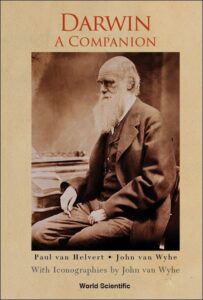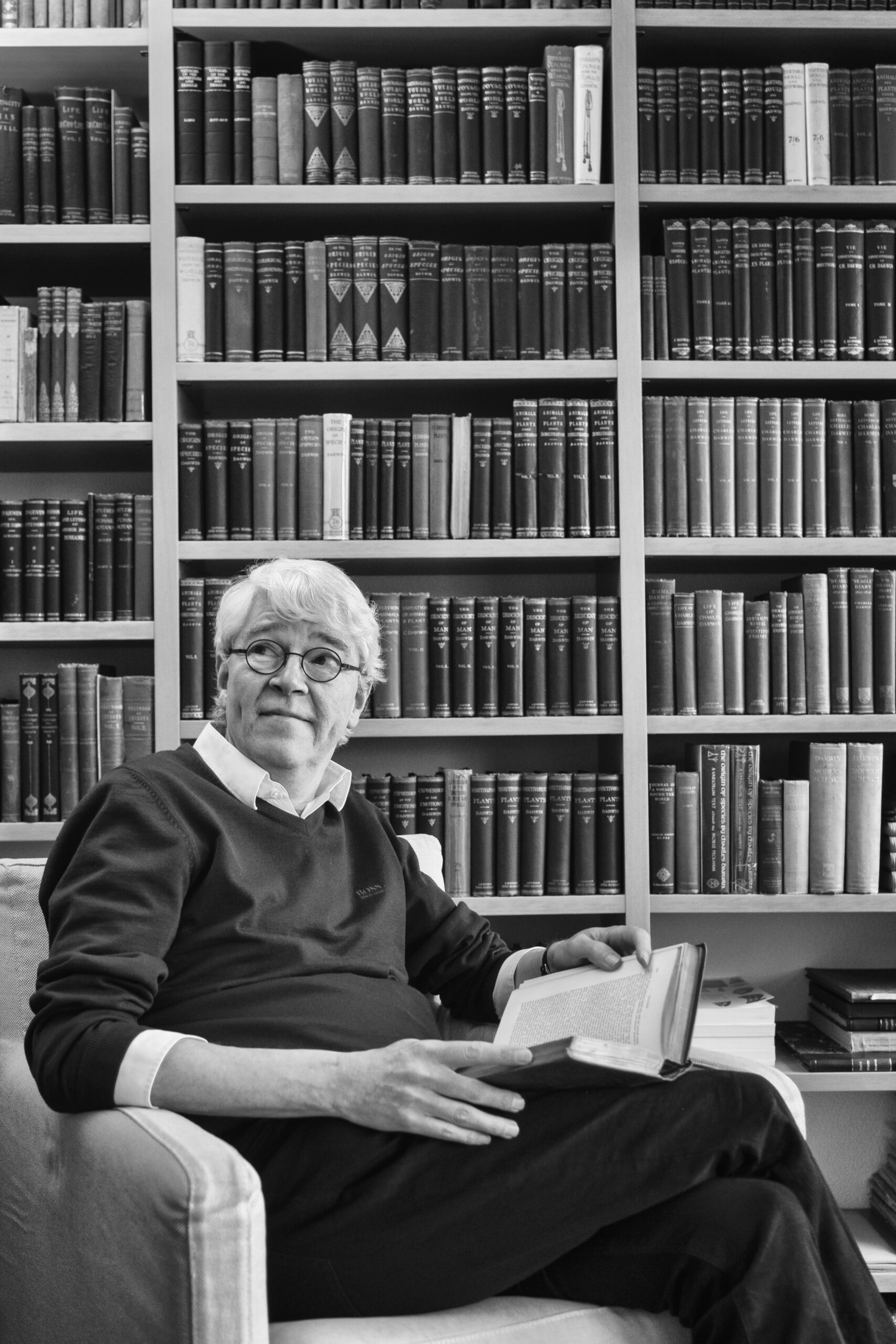Darwin mania is not something you can do justice to in one handy guide. But Paul van Helvert gives it his best shot in Darwin. A Companion.
Darwin is dead – and will have been for 129 years come 19 April. But the Darwin industry is still going strong. ‘You only have to write a book with Darwin in the title, and it will get published and will sell,’ says Van Helvert. ‘There just is a lot of interest in Darwin.’ Van Helvert, a patent expert at WUR, realizes he is jumping on that bandwagon. He and science historian and Darwin expert John van Wyhe (National University of Singapore) have written a 466-page guide to Darwin. To call it an encyclopaedia is no exaggeration.
Our discussion of the book must start with Van Helvert’s own Darwin mania – if only because we are sitting in front of an impressive bookcase full of volumes by Darwin. A wall of the brown and green spines of countless editions of Darwin’s books published in Britain and elsewhere during his lifetime. A collection Van Helvert started on the advice of a colleague.
You collect these thanks to a colleague?
‘Yes. Dick Peters, one of my supervisors when I was a student, came to my office one day. You are too busy, he said, you need a hobby. And he chucked a catalogue of a Darwin auction in London onto my desk. That was in 1992.’
And? Did you buy anything?
‘A third edition of On the Origin of Species. I wanted to bid for the second edition really, but bidding started at 2000 pounds and that was too much for me. First editions are totally out of reach for ordinary mortals nowadays. There was a very fine one for sale there, which was valued at 12,000 to 15,000 pounds. Bidding started at 9500 but nobody bid. Later I asked what had happened to that copy. Not long after the auction it sold for 30,000 dollars in America. Now it’s worth 400,000. It’s an expensive hobby.’
You’ve got a lot, but not everything. What is still on your financially doable list?
‘The first edition of The Descent of Man. I must get hold of that. Without that book, there’s a gap in my collection. The first edition, I mean: I’ve got most of the subsequent editions. It gets put up for sale quite often but so far there hasn’t been a copy that was acceptable to me at a moment when I could afford it. Because that’s another criterion of mine – they’ve got to be “fine copies”, as they are called. Not a repaired or rebound copy – I’m not interested in those. They are not original or attractive enough for me.’
There are a lot of Darwin collectors but Paul van Helvert can lay claim to being the biggest in the Netherlands.
You are too busy, he said, you need a hobby
He is not just a collector of Darwin’s work, but also a great expert on the subject. His collection of books about Darwin is at least as big as that of Darwin’s own books. And now he can add a volume of his own: Darwin. A Companion. A kind of sequel to Charles Darwin. A Companion, published in 1978 by R.B Freeman.
What happened to the Charles in the earlier book’s title?
‘We left it out to make clear this is a different book. It’s not a second edition but a new version. The book is based on the first one, but it is far more extensive. The first book was 100,000 words and this one is 235,000. There are loads of new topics in it.’
Was this a book that had to be written?
‘Yes. There is a demand for it. There are lots of good things in the 1978 edition, but there are a great many mistakes in it too. So the new version had to be done at some point. Freeman toyed with the idea himself, but he passed away in 1985.’
Why you?
‘It came my way, really. I met John van Wyhe in Cambridge in 2009. He manages the Darwin Online website and he had put Freeman’s book on it two years previously. I said, ‘You do know there are a lot of mistakes in that book, don’t you?’ And he replied, ‘Then it’s time you corrected it.’ To be honest, that had been in the back of my mind for some time, but I was daunted by the task. I knew it would be an awful lot of work. You’ve got to be really keen to painstakingly correct a book from A to Z.
It’s a useful, worthwhile book, but it is not a scientific work
It is the sort of work that suits me, though: checking things, correcting facts, collecting material and adding things. And that was how we divided the roles. Van Wijhe did all the iconography, with an overview of all the known pictures of Darwin taken throughout his life. I did the rest of the book.’

The book includes lists of all the 350 visitors Darwin received (individuals, couples and groups), the 38 different theories about his illness, and an inventory of the 130 tributes to him around the world, ranging from postage stamps to statues. You name it, it’s in there
Who wants to know all that?
‘There are enough Darwin maniacs in this world. It’s not so much a question of wanting to know as wanting to have the information. There’s a difference there: it’s about access to information. I can well imagine that not everyone is all that interested in how many times Charles Darwin’s neighbour popped in, but there are people who want to know about that.’
The Darwinstraat in Ede is missing from the summary of street names
‘A list of all the Darwin streets in the world would be a volume in itself. On some topics, we just give an impression, and our choices are subjective. The book had to be affordable, and a complete encyclopaedia on Darwin would be impossible. But we did for example aim at a complete list of all the plants named after Darwin. There are already more than 700 of them at this point.’
If time travel were possible, which day in the life of Darwin would you like to witness?
‘18 June 1858. That was the day he got Wallace’s letter enclosing his article on natural selection. On that day, Darwin realized he was actually too late. He had already started writing his major work The Origin. At the time, Wallace was on Celebes in Indonesia, where he posted the letter on 9 March. The letter has since been lost. A few years ago, a controversy blew up around the date on which Darwin received the letter. Might he have received it earlier after all, and had he secretly lifted some of Wallace’s ideas? We now have enough evidence that that was not the case. But it would be nice if I could go back in time and talk to the postman. Just to check whether it really was 18 June.’
Is this book your life’s work?
‘No. This is something that had to be done. It’s a nice book and it contains a lot of information. It’s useful and worthwhile, but it is not a scientific work. The question that has never adequately been answered is: how did Darwin arrive at his theory of evolution? What led him to it? There are a few well-argued theories, but I don’t find any of them satisfactory. I’ve been thinking about this for 30 years. That’s the book I would love to write. But whether I ever will, I don’t know.’

 The question that has never adequately been answered is: how did Darwin arrive at his theory of evolution?’ Photo: Guy Ackermans
The question that has never adequately been answered is: how did Darwin arrive at his theory of evolution?’ Photo: Guy Ackermans